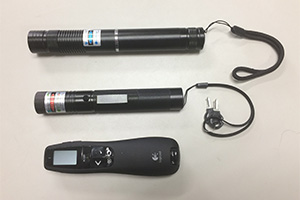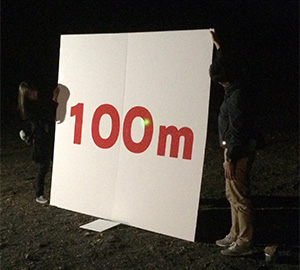Top>Opinion>Properly Using Laser Pointers Danger of Laser Beams Being Pointed at Aircraft
 Index
Index
Properly Using Laser Pointers
Danger of Laser Beams Being Pointed at Aircraft
Ichiro Shoji
Professor, Faculty of Science and Engineering, Chuo University
Areas of specialization: Lasers, Nonlinear Optics
2015: a record year for laser pointer-related incidents
On the night of October 17, 2015, as a passenger aircraft descended to an altitude of 300 meters on its way to land at Osaka International (Itami) Airport, a green light, believed to be a laser, was beamed onto the window of the aircraft’s flight deck. This incident was reported in the media in November. Then, in December, a man was arrested on a charge of forcible obstruction of business after a laser beam was pointed at a U.S. military aircraft flying in airspace around the U.S. military’s Futenma airfield. This was apparently the first time anywhere in Japan that criminal charges were pursued in a case involving a laser beam being pointed at an aircraft.
This does not mean that this kind of thing has never happened before. In fact, in the six years since 2010, when the Ministry of Land, Infrastructure, Transport and Tourism started compiling statistics, there has been a total of 161 such incidents. It is possible, however, that last year’s extensive media coverage prompted a spate of copycat offenses, with a record 47 cases being reported in the twelve months of 2015.
Fortunately, there have been no reports to date of direct impact on the operation of any aircraft or the health of any pilots. However, as I will discuss later in this article, a single misstep could result in a serious accident, so this kind of behavior must never be allowed. So, why do these incidents occur? What exactly are the lasers that are being used in these incidents?
What is laser?
Firstly, in answer to the question of why laser beams were used in these incidents, it is because it would be virtually impossible to shine any other kind of light, such as the beam of a torch, for instance, on an aircraft flying several hundred meters in the air. This illustrates the special nature of laser light. It is so unique that we could divide all of the kinds of light that exist in the world into “laser light” and “non-laser light.”
Laser is a man-made light that was first produced in 1960. I will not go into the principles of how it works, except to say that laser light has three main characteristics: (i) it is highly directional, (ii) it is highly monochromatic, and (iii) it has high optical intensity.
(i) refers to the ability of narrow beams to travel long distances in a straight line without spreading. A balls thrown by Ichiro, the famous Japanese player in the American Major Baseball League, is often described as being like a laser beam because the ball’s trajectory does not form an arch, but instead it travels in a straight line, like a thread being pulled. (ii) means that laser beams usually contain only a single color (or wavelength in specialist terminology). For example, red lasers are only red, and contain no blue or green elements. (iii) is also referred to as power density, and it means that energy is concentrated in a small area.
On the other hand, natural light such as sunlight, as well as the light from electric light bulbs and fluorescent lights and the like, have almost completely the opposite properties. These kinds of light spread out immediately as soon as they leave the source, and they usually contain all colors continuously. Moreover, even if we try to concentrate this light in a small area, it spreads out straightaway and there is a limit to how much its power can be increased.
One product that has been developed to take advantage of these excellent qualities of laser light is the laser pointer. Laser pointers are in wide use in classrooms and conference rooms to point at slides on a projector screen during presentations. The presenter shines a bright red or green pinpoint beam to point out the part of the slide that he or she is currently explaining. This is something that can only be done with lasers.
Laser classifications by output power and legal restrictions

From bottom to top: Laser pointer sold in Japan, laser pointers with output approximately 50 times and 1,500 times the Japanese standard
Today, lasers are used in a wide range of fields, such as manufacturing, medicine, and telecommunications. In particular, lasers used in industrial applications are powerful enough to melt or cut metal. For this reason, JIS has established safety standards for the appropriate use of laser devices. Under these standards, lasers are classified in four stages depending on their output. Laser pointers sold in Japan fall under Class 2, which is the second weakest class. The output for lasers in this class is 1 mW or less, which is of a level that, even if it were momentarily shone into someone’s eyes, it would not harm the retina.
Recently, however, laser pointers with outputs that are dozens or even thousands of times more powerful than the Class 2 standard are being made overseas. Photograph 1 shows, from the bottom up, a laser pointer that complies with the Class 2 standard, one with an output of approximately fifty times the standard, and another with an output of approximately 1,500 times the standard. As output increases, the size of the device also increases slightly, but they operate with normal batteries and can be carried around easily. In experiments I conducted in my laboratory, when the laser pointer with the output of 1,500 times the standard was shone on black paper and a black T-shirt, the light was absorbed and heat was generated to the extent that smoke was produced and the target material caught fire.
The Consumer Products Safety Act prohibits the sale of these laser pointers that exceed the standard in Japan. However, there are, as yet, no restrictions on buying them overseas and bringing them into Japan or purchasing them from overseas online shopping sites and importing them directly. In effect, therefore, they are readily accessible to anyone.
How far does light from laser pointers travel?

Green light from a laser pointer shone on a target 100 meters away.
Can the light from a laser pointer really reach an aircraft flying several hundred meters above the ground? Let us assume that to “reach” here means that the beam striking its target is visible to the human eye.
As mentioned above, laser light is highly directional, but even so, as it travels, the beam gradually becomes wider and starts to diverge. Photograph 2 shows a beam from a standards-compliant laser pointer being shone on a target 100 meters away. While the green light is discernible, the beam has grown from around 2 millimeters directly out of the laser pointer to around 10 centimeters when it reaches the target. As the beam grows larger, it loses energy density, so it is dimmer to the eye than when it is shone on something up close. The further away the target, the dimmer the light becomes. In my experiments, 300 meters was the limit at which it remained visible to the eye and it became very difficult to shine it on the target.
In the kinds of incidents described above, given that, even though the aircraft was a moving target, the laser beam was shone on the window of the flight deck some 300 meters away, I believe that it is highly likely that the laser pointers used were high-power devices that do not comply with Japanese standard. In fact, when I used a laser pointer that was 50 times the standard, I could easily shine it on a target 300 meters in the distance. When the laser pointer was fixed to a stand and adjusted, I found that it could even reach a target 700 meters away.
Cannot be excused as pranks
Laser pointers were developed with the objective of making presentations more effective. When used for their intended purpose, the standard output is sufficient. However, as technology has advanced, devices that, although little different in size, have an output of a different order of magnitude are now being produced. That kind of over-engineered device would serve no useful purpose in daily life. Still, I imagine that many people, if they had the chance, would want to test how far the light from one of these devices would travel. I think that this is the reason why aircraft flying overhead are being targeted.
Many of these incidents may have been intended merely as pranks, but when such high-power lasers are shone up on flying aircraft, even though their energy output may have dissipated, if the light strikes the pilot’s eyes, it is quite conceivable that the glare could force the pilot to close his or her eyes, or that it could damage the pilot’s retina. This could affect the piloting of the aircraft, and there is no denying the possibility that it could lead to an accident. Also, even just seeing the laser beam shining on the window has, I am told, caused pilots to feel a considerable psychological burden.
Firstly, this kind of behavior must be strongly discouraged. It is also important, fundamentally, that people not have access to these high-power laser pointers. Achieving this would require that consideration be given to placing legal restrictions on the possession of such devices in the future.
Laser is a convenient tool that is indispensable in contemporary society. It is my fervent hope that people will use lasers appropriately and with the correct knowledge of what they are capable of.
- Ichiro Shoji
Professor, Faculty of Science and Engineering, Chuo University
Areas of specialization: Lasers, Nonlinear Optics - Professor Ichiro Shoji was born in the city of Muroran in Hokkaido in 1969. He graduated from the Department of Applied Physics of the Faculty of Engineering, The University of Tokyo, in 1992. In 1994, he completed the Masters Course of the Department of Applied Physics of that university’s Graduate School of Engineering, going on to start the same Department’s Ph.D. course before withdrawing before completion in 1995.
Ph.D. (Engineering, The University of Tokyo)
After serving as a research associate at the University of Tokyo and the Institute for Molecular Science, he obtained a position at Chuo University in 2004. He served there as Assistant Professor and Associate Professor before taking up his current post in 2010.
He is currently engaged in characterization of laser materials and the research and development of high-performance compact solid-state lasers, using technology he has developed himself.
- Research Activities as a Member of Research Fellowship for Young Scientists (DC1), Japan Society for the Promotion of Science (JSPS) Shuma Tsurumi
- Important Factors for Innovation in Payment Services Nobuhiko Sugiura
- Beyond the Concepts of Fellow Citizens and Foreigners— To Achieve SDGs Goal 10 “Reduce Inequality Within and Among Countries” Rika Lee
- Diary of Struggles in Cambodia Fumie Fukuoka
- How Can We Measure Learning Ability?
—Analysis of a Competency Self-Assessment Questionnaire— Yu Saito / Yoko Neha - The Making of the Movie Kirakira Megane









